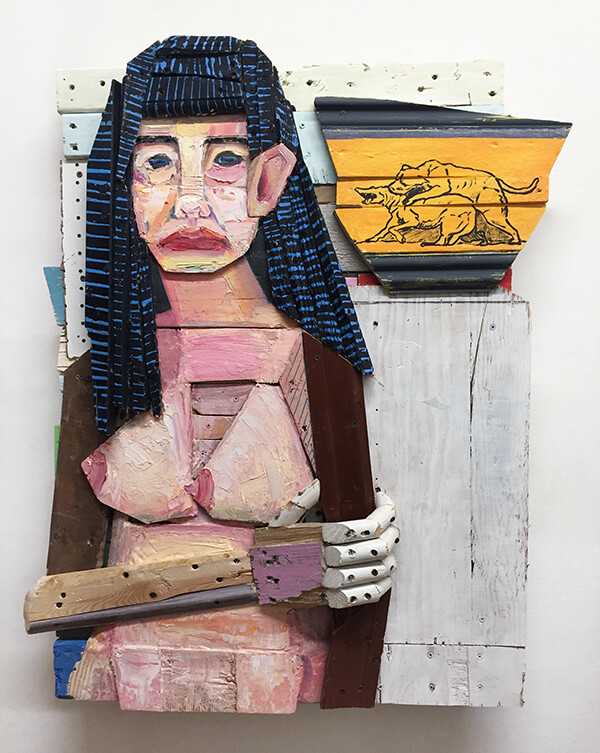Nicolas Holiber: Striving For Perfectly Imperfect Art


Brooklyn-based artist Nicolas Holiber is an avid collector of urban detritus. Gathering the often-ignored scraps strewn across city streets including wooden shipping pallets and other industrial objects familiar to dwellers of sprawling metropolises, Holiber revitalizes these materials by converting their scraped, faded, splintered, cracked and uneven surfaces into unconventional three-dimensional artistic gestures.
In his current exhibition Stolen Idols on view at Harlem’s Gitler & _____ until April 11, Holiber introduces his recent focus on still life through captivating and colorful wall-mounted compositions filled with fruit, skulls and classical Roman busts. Admitting he was influenced by “Baroque still life, Cubism, pre-Raphaelite painters and American folk art,” Holiber pursues a rich engagement with art historical narratives as previously seen in his monumental public sculpture Head of Goliath in Tribeca Park. Cleverly and masterfully, Holiber juxtaposes these studied and precise art historical references with his fascination with the textural imperfections of his materials.
We spoke with Holiber about his interest in still life, the importance of gathering materials to his creative practice and how he would like to affect viewers both inside galleries and on the streets.
In your exhibition Stolen Idols at Gitler & _____, you transitioned from portraits to largely, still life. What led you to begin creating still lifes?
A lot of the images I make arise out of my working process. So, I had built several panels not really knowing what I would turn them into and there was a piece of plywood on my studio floor that had been cut into a kind of rhombus shape. It looked like the perfect table top, so I drilled it to the panel and went from there.

There’s a fascinating juxtaposition in the new works between the precise tradition of classical sculptural busts and your purposefully imperfect materials. What inspired you to engage with this art historical past?
The art historical references come about because these things have always interested me and continue to interest and inspire. Most of the time when we go to a museum to see these classical sculptures, they’re in pieces or fragments, so in a sense, they are very imperfect. I’m interested in making things that are perfectly imperfect.

You use untraditional materials in your art such as found wood from shipping pallets. When and how did you begin to work with this unexpected material from the city streets?
I began using shipping pallets in grad school when I needed to build a stage floor for an installation I was planning. The installation idea eventually fell through and I was left with five to six raw pallets. I thought, well, I could at least try painting on them.

It seems like the process of gathering and creating out of rejected detritus is an essential part of your practice. What is your artistic process?
I used to gather a lot more than just pallets, but my studio space just became full of stuff I never used. Now I am much more selective in what I take off the street, but collecting is definitely an essential part of my process. After I bring things into my studio, they usually get painted in some capacity with enamel or acrylic. If it’s a pallet, I’ll break it down and make a panel, or if it’s some different kind of wood, I’ll start chopping it up or throw it in a corner. I have a cache of wood pieces–small fragments of irregular shapes and sizes that I can start building with. So, if I’m making a wall piece, I’ll start adding to the panel or if I’m making a free-standing sculpture, I’ll start building from the bottom up.

Perhaps your most well known work is your public installation Head of Goliath. How does your approach to public sculpture differ from your wall-mounted gallery work? Do you have a preference for either?
The wall-mounted pieces differ a lot from the more traditional sculptures such as Head of Goliath. When I work with pieces on the wall, there is more room for me to play with perspective and compression of space, etc. And I can have more variety in what image(s) I make. With something like Goliath, I’m more focused on one point of view and one idea. There’s no difference between my large public pieces and my other sculptures except size. I see the wall pieces as completely different–a combination of painting and sculpture.

Since your work can be viewed both in the streets and in galleries, how would you like your work to affect viewers?
Hopefully by presenting them with something interesting that raises questions about art, their daily life and materials they come into contact with. Give them something to think about and appreciate.









Responses